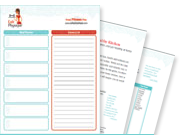Appetizer
Read MORE nutrition labels. Learning to read the nutritional information panels included on all packaged foods is one of the most beneficial things you can do. There are no magic foods that work wonders for everyone, so being educated about the nutritional value (or lack thereof) of the foods on your grocery store shelf, will allow you to make the best decisions based on your body and your goals.
Main Course
(1) Serving Size: This is the first thing you should look at on any label because it tells you how much of the food is considered a single servings and how many servings are in the package. This section makes it easy for you to compare similar foods because the serving sizes are standardized and shown in familiar units like cups or pieces, followed by the metric amount (i.e. # of grams)
Example: A single serving is 1 cup of macaroni & cheese, and there are 2 servings in the container.
(2) Calories: The calorie section of the label can help manage your weight according to your goal (i.e. gain, lose, or maintain). This is often considered the most important part of the label because many people eat too many calories.
Example: There are 250 calories in each serving (1 cup), and 110 of those calories come from fat. However, you have to remember that the actual number of calories you take in depends on the number of servings you eat. If you the whole container (w servings), you will consume 500 calories, 220 of which will come from fat.
Nutrients: The government breaks nutrients out into 2 categories, although they will not be broken out on the labels you see in the store, so you need to learn this information.
(3) Limit These: Fat, saturated fat, trans fat, cholesterol, and sodium can all increase your risk of heart disease, some cancers, and high blood pressure, so you should carefully evaluate foods in these areas.
(4) Get Enough of These: Getting enough dietary fiber, vitamin A, vitamin C, calcium, and iron in your diet can improve your health and help reduce the risk of some diseases. So, be sure to choose foods that will help you increase your intake of these nutrients.
(5) Footnote on the Bottom: The * used after the “%Daily Value” heading on the label refers to the footnote in the lower part of the nutrition label, which tells you “%DVs are based on a 2,000 calorie diet”. The FDA requires that this statement be on all food labels. The remaining information in the full footnote may not be on the package if the size of the label is too small. When the full footnote does appear, it will always be the same. It doesn’t change from product to product, because it shows recommended dietary advice for all Americans–it is not about a specific food product.
Example: By looking at the footnote, we see that it is recommended that a person on a 2,000 calorie-a-day diet consume no more than 65g of fat per day. 1 serving of this mac & cheese contains 12 grams of fat which is 18% of that daily allowance. Again, if you have 2 servings (2 cups), you will consume 24 grams of fat, and that would amount to 36% of your daily allowance – assuming you are on a 2,000 calorie-a-day diet. This leaves you with no more than 41g of fat to be spread across your meals for the remainder of the day.
(6) % Daily Values (%DVs): These are based on the Daily Value recommendations for key nutrients but only for a 2,000 calorie daily diet which may or may not be the accurate number of calories that you consume in a day. However, you can still use the %DV as a frame of reference no matter what your actual calorie intake is.
It’s important to realize that the %DV column doesn’t add up vertically to 100%. Instead each nutrient is based on 100% of the daily requirements for that nutrient (for a 2,000 calorie diet).
(7) Nutrients Without a % Daily Value:
* Trans Fat: Experts agree that trans fat raises LDL (“bad”) cholesterol levels which can lead to coronary heart disease. Given that this is the leading cause of death in America, the government recommends that we not consume ANY trans fats, so there’s no recommended % DV.
* Protein: A %DV is required to be listed if a claim is made for protein, such as “high in protein”. Otherwise, unless the food is meant for use by infants and children under 4 years old, none is needed. Current scientific evidence indicates that protein intake is not a public health concern for adults and children over 4 years of age.
* Sugar: The government has not established a daily reference value for the amount of sugar that should be consumed in a day. Please remember that the sugars listed on the nutrition label includes naturally occurring sugar like fructose (found in fruit) as well as those that are added artificially. You have to look at the product ingredients to determine which types of sugar are included.
If you are concerned about your intake of sugars, make sure that added sugars are not listed as one of the first few ingredients. Other names for added sugars include: corn syrup, high-fructose corn syrup, fruit juice concentrate, maltose, dextrose, sucrose, honey, and maple syrup.
To limit nutrients that have no %DV, like trans fat and sugars, compare the labels of similar products and choose the food with the lowest amount.
Source: U.S. Food and Drug Administration
Dessert
While being faced with tons of nutrition labels every time I go grocery shopping can be intimidating, I have to admit that being able to easily read and understand them gives me a sense of empowerment. I don’t have to rely on anyone else to tell me what’s good for me and what’s not because I can see for myself.
For me, the most surprising information I typically find on a food label is the serving size. I guess I feel like if there’s only 1 of something in an individual package, that should be 1 serving because it’s rare that someone would actually only eat half of it. But, oftentimes, this is not the case. You may only be eating 1 cookie, but a quick look at the label can let you know that the cookie is equal to 2 servings. Once you double all of the calories, calories from fat, sugar, carbs, etc., you’ll realize that the cookie is costing you (and your hips) more than you bargained for.
 Other big offenders in my book are bagged snacks. If I’m on a road trip or am having a snack attack, I like to eat popcorn. I usually end up with Smart Food White Cheddar Popcorn from Frito Lay because it’s tasty and it’s available in most convenience stores. Since it usually takes the whole bag to satisfy me, I figured that each bag probably contained 1 or 2 servings, but the joke was on me this time. As you can see below, each bag of this stuff contains 5 servings! That means that by eating the entire bag, which I’ve done more times that I care to recount, I am consuming 30 grams of fat (6g per serving x 5 servings) which is nearly ½ of my fat limit for the day.
Other big offenders in my book are bagged snacks. If I’m on a road trip or am having a snack attack, I like to eat popcorn. I usually end up with Smart Food White Cheddar Popcorn from Frito Lay because it’s tasty and it’s available in most convenience stores. Since it usually takes the whole bag to satisfy me, I figured that each bag probably contained 1 or 2 servings, but the joke was on me this time. As you can see below, each bag of this stuff contains 5 servings! That means that by eating the entire bag, which I’ve done more times that I care to recount, I am consuming 30 grams of fat (6g per serving x 5 servings) which is nearly ½ of my fat limit for the day.
Not good, Folks. Not good at all.
About Cafe Physique:
The mission of Café Physique is to help clients reach and exceed their personal fitness and nutrition goals. If you’re in need of an a nutritionist in Atlanta or an Atlanta personal trainer – Café Physique is the perfect solution. We offer Atlanta yoga instruction, Atlanta prenatal workouts, and Atlanta personal training. We also have private sessions of pilates that Atlanta residents are raving about. We invite you to let a member of our Atlanta registered dietitian staff or personal training team develop and implement a realistic and healthy lifestyle plan to meet your personal goals.



